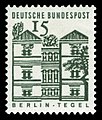Tegel Castle
The Tegel Castle (also Humboldt castle called) is located in the Berlin district of Tegel the district Reinickendorf . It is the most important monument in the district and, like the farm building and the wall, gardener's house, family grave with a statue of hope and Kunth grave, is a listed building. The brothers Wilhelm and Alexander von Humboldt spent many years of their childhood in the previous castle and at Gut Tegel in the summer. The castle park extends almost to the Tegeler See .
Today's Tegel Castle was built between 1820 and 1824; The client was Wilhelm von Humboldt, its architect Karl Friedrich Schinkel . It still belongs to the descendants of Wilhelm von Humboldt, the von Heinz family, who also live here. The private Humboldt Museum in the building is open to the public on Mondays during the summer months.
history
Originally, in 1558 as a Renaissance - mansion built, took place at the instigation of the Elector Friedrich Wilhelm von Brandenburg of conversion to a hunting lodge .
Early 18th century was one at the entrance to the castle milestone in the form of an obelisk made of sandstone placed the two Prussian mile from the central post Stein am Dönhoffplatz in Berlin-Mitte is removed. The milestone was restored in 1992 and is now located southeast of the castle on Adelheidallee.
As part of the Tegel estate , the castle passed to the von Humboldt family through marriage in 1766. Tegel Castle became the family seat of the Humboldts. Even Alexander and Wilhelm von Humboldt lived here for many years. After the death of his mother Marie-Elisabeth von Humboldt , Wilhelm von Humboldt took over the property in 1797. From 1820 to 1824 he had the palace redesigned by Karl Friedrich Schinkel in the classicism style. Wilhelm von Humboldt's daughter Gabriele later inherited the property. She was married to the Prussian Foreign Minister Heinrich von Bülow . After Gabriele von Bülow's death, the Tegel property passed into the hands of daughter Constanze von Heinz, whose descendants still live in the house today. Ulrich Vincenz von Heinz (born July 6, 1941) died on May 30, 2017 and was buried with family and friends in the family crypt of the castle.
The park was originally laid out in the years 1777 to 1789 by the manager and tutor of the Humboldts, Gottlob Johann Christian Kunth . From 1802, Wilhelm von Humboldt continued to develop his form. The often widespread authorship by Peter Joseph Lenné has turned out to be a wrong attribution.
In 1983 the castle park was placed under monument protection. On its west side near the Tegeler See there is a supposedly 800-year-old oak, the fat Marie , as she was called by the Humboldt brothers after their cook. Near the castle is the monumental Humboldteiche with a chest height of 7.80 m (as of 2018).
The family grave
The grave site designed by Schinkel in 1829 for Caroline von Humboldt , the wife of Wilhelm von Humboldt, is also located in the palace grounds . Wilhelm did not have a gravestone erected for her, but a monument with a Roman goddess Spes, created in marble by Bertel Thorwaldsen, on a high granite column. Wilhelm acquired the work of art, loved by Caroline since her Roman days, after her death. In the tomb there is no reference to the risen Christ, as Theodor Fontane erroneously said. Wilhelm and Alexander von Humboldt were also buried here, as were the descendants of Caroline and Wilhelm von Humboldt to this day. The uniformly designed gravestones without decoration and the flat grave mounds are arranged in rows and appear simple. A semicircular stone bench (" Exedra "), which is very simple by Schinkel's standards, frames the "Hope Pillar" from behind.
Postage stamp of the Deutsche Bundespost (1969) from the series German Buildings from Twelve Centuries
See also
literature
- Christine and Ulrich von Heinz: Wilhelm von Humboldt in Tegel. A picture program as an educational program . Deutscher Kunstverlag, Munich / Berlin 2001, ISBN 3-422-06353-6 .
- Paul Ortwin Rave: Wilhelm von Humboldt and the Tegel Castle . Koehler & Amelang, Leipzig 1950.
- August Wietholz: The manor and Tegel Castle . In: Mitteilungen des Verein für die Geschichte Berlins , 48, 1931, pp. 74–84.
- Clemens Alexander Wimmer: Parks and Gardens in Berlin and Potsdam ; ed. Senator for Urban Development and Environmental Protection, Section III - Garden Monument Preservation. 3. Edition. Nicolaische Verlagsbuchhandlung, Berlin 1989, ISBN 3-87584-267-7 , pp. 55-58.
- Marcel Piethe: Wilhelm von Humboldt and Tegel Castle. In: Die Mark Brandenburg , Issue 63, 2006. Marika Großer Verlag, Berlin, ISBN 978-3-910134-22-5 .
Web links
- Entry in the Berlin State Monument List
- Tegel Castle as a Berlin attraction
- Tegel Castle. In: arch INFORM .
- C. Schmidt On Humboldt's traces of spring in Alt-Tegel ( Memento from March 14, 2017 in the Internet Archive )
- Theodor Fontane : Walks through the Mark Brandenburg , Volume 1, Chapter 209, description of the castle
Remarks
- ↑ stadtentwicklung.berlin.de
- ^ Humboldt Museum in Tegel Castle
- ^ Entry in the directory of monumental oaks . Retrieved January 10, 2017
- ↑ The mother of the brothers had already set up a family crypt for herself and her husbands in the Falkenberg village church .
Coordinates: 52 ° 35 ′ 42 ″ N , 13 ° 16 ′ 35 ″ E








